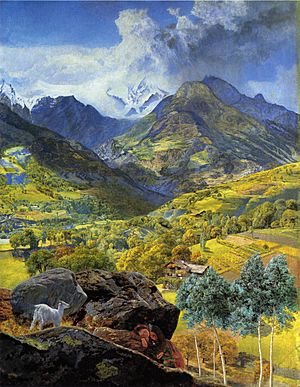John Brett (artist) facts for kids
John Brett (born December 8, 1831 – died January 7, 1902) was a British artist. He was part of a group called the Pre-Raphaelite movement. This group of artists believed in painting nature with great detail and bright colors. Brett was famous for his very detailed paintings of nature, especially landscapes.
His Life and Art
John Brett was born near Reigate, England, in 1831. His father was an army vet. His sister, Rosa Brett, was also an artist. They even shared a studio for a while.
In 1851, John started taking art lessons. He learned from landscape painters like James Duffield Harding. Later, he joined the Royal Academy Schools in 1853. However, he was more interested in the ideas of John Ruskin. Ruskin was a famous art critic. Brett also met artist William Holman Hunt, who was a key Pre-Raphaelite.
Hunt believed in painting landscapes very scientifically. This meant showing every detail exactly as it was. Inspired by this idea, Brett traveled to Switzerland. There, he painted detailed landscapes. He also learned from another artist, John William Inchbold.
Famous Paintings
In 1858, Brett showed his painting called The Stonebreaker. This artwork made him well-known. It showed a young person breaking stones for a road. The landscape around them was very bright and full of tiny details.
John Ruskin was very impressed by the painting. He loved the exact details of the rocks and plants. Ruskin thought Brett could paint a masterpiece if he visited the Aosta Valley in Italy. With some money from Ruskin, Brett went to Italy. He painted The Val d'Aosta in 1859. Ruskin praised this painting highly and even bought it.
Brett continued to paint very detailed landscapes. He often stayed in Italy during the 1860s. He always wanted to show nature with scientific accuracy. He also added deeper meanings to his art, just as Ruskin suggested.
Later Years and the Sea
Later in his life, Brett painted more coastal scenes and seascapes. He became very familiar with the sea. This was because he owned a large boat called Viking. It was a 210-ton schooner with a crew of twelve. He used it to travel around the Mediterranean Sea.
In the 1880s, Brett rented a castle in Newport, Pembrokeshire. He used it as a base for his large family. From there, he painted, sketched, and took photos of the coasts of Wales. Many of his works from this time were shown in an exhibition in 2001. It was called John Brett - a Pre-Raphaelite on the Shores of Wales.
Other Interests
John Brett was also very interested in astronomy. He had studied the stars since he was a child. In 1871, he became a member of the Royal Astronomical Society. This shows he was not just an artist but also a scientist at heart.
Brett also helped start the Art Workers' Guild. He was chosen as its Master in 1890. This group helped artists and craftspeople.
See also
 In Spanish: John Brett para niños
In Spanish: John Brett para niños
- List of Pre-Raphaelite paintings - See more artworks from the Pre-Raphaelite movement.
- The Stonebreaker - Learn about another famous painting with the same name by Henry Wallis.




